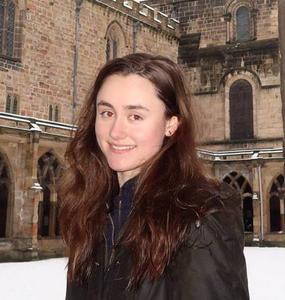ESP Biography
CHRISTINA SMITH, Insular Medievalist. West Highland fiddler.
|
Major: Classics College/Employer: Stanford Year of Graduation: 2016 |

|
Brief Biographical Sketch:
Christina Smith (Stanford BA 2016) graduated Phi Beta Kappa from Stanford University, California, with a major in Classics and a double minor in Medieval Art History and Archaeology. She holds a MLitt with Distinction in Early Medieval Scottish History from the University of Glasgow, UK (2017) and a second MA with Distinction in Early Medieval Archaeology from Durham University, UK (2018). She is currently pursuing a fully-funded PhD in Medieval Archaeology at Durham (2018-2022). Her thesis examines the emergence and development of the free-standing ('high') cross in Britain in the period between AD 600-1100. She's often found with a fiddle bow in hand, having played traditional Scottish music since the age of 8. When she isn't looking at random high cross fragments, she's hanging around labrador retrievers. Send her an email at christina.smith@alumni.stanford.edu, should you like to discuss all things (early) medieval, Stanford, or Scottish! Past Classes(Clicking a class title will bring you to the course's section of the corresponding course catalog)R4279: Of Mice and Monks: The Early Celts of Britain in Splash Spring 2015 (Apr. 11 - 12, 2015)
Ever read about King Arthur? Seen the Loch Ness Monster? Imagined yourself as Princess Merida in Disney's "Brave"? Wondered who St. Patrick was? Heard a bagpipe or fiddle?
If you answered 'yes' to any of the above (or if you wish you had), this is the class for you!
This class will cover some basic questions: Who were the Celts? Where did they live? How was their society structured? Did they really paint their bodies before running into battle? Where do the faeries and monsters come in? And, why do they have such staying-power in our imagination?
We will cover the emergence of the Picts (Pictī) -- those Celts whom the Romans encountered 2,000 years ago. From there, we'll follow them into battles, castles, and monasteries, exploring book production and cultural innovation.
Activities include the following:
(1) Trying your hand at writing calligraphy in medieval handwriting (script). Touching vellum (actual animal skin) -- the most important "ingredient" in medieval book-making.
(2) Looking at real medieval manuscripts (books).
(3) Watching and discussing exciting scenes of Celts in "Brave," "How to Train Your Dragon," "The Secret of Kells," "King Arthur," etc.
(4) Listening to Scottish and Irish music with medieval antecedents. Trying out step dancing, if you like.
(5) Learning some Gaelic and Latin words (and if you want more than just a couple, I'm here to provide that as well!).
(6) Eating snacks (because that was a medieval activity too).
R3875: How to train your dragon: Vikings, Celts, Princesses, and Monks in Splash Fall 2014 (Nov. 08 - 09, 2014)
So what's really behind the medieval world of the Vikings and Celts, as portrayed in many a major-motion picture, such as "How to Train Your Dragon" or "Brave"?
This class will cover some basic questions: Who were the Celts? What types of people made up their society? What about the dragons and faeries? Why did Vikings attack monasteries? What were monks doing there anyway?
Though the class will have brief historical background of the early Middle Ages, we will dwell more on saints' hagiographies ("lives" in Latin) which mention monsters, curious images in medieval books belonging to princesses, and artifacts (like swords and jewelry) found at sites like monasteries and castles.
Activities include the following:
(1) Trying your hand at writing with a quill and ink on vellum (actual animal skin!).
(2) Listening to some traditional Scottish and Irish music with medieval antecedents.
(3) Looking at a real medieval manuscript (book).
(4) Learning a couple of Latin and Gaelic words (and if you want more than just a couple, I'm here to provide that too).
(5) Watching a few clips from "How to Train Your Dragon" and "Brave."
(6) Eating snacks (because that was a medieval activity too).
|
|
